check engine Oldsmobile Achieva 1997 s Owner's Guide
[x] Cancel search | Manufacturer: OLDSMOBILE, Model Year: 1997, Model line: Achieva, Model: Oldsmobile Achieva 1997Pages: 372, PDF Size: 18.52 MB
Page 201 of 372
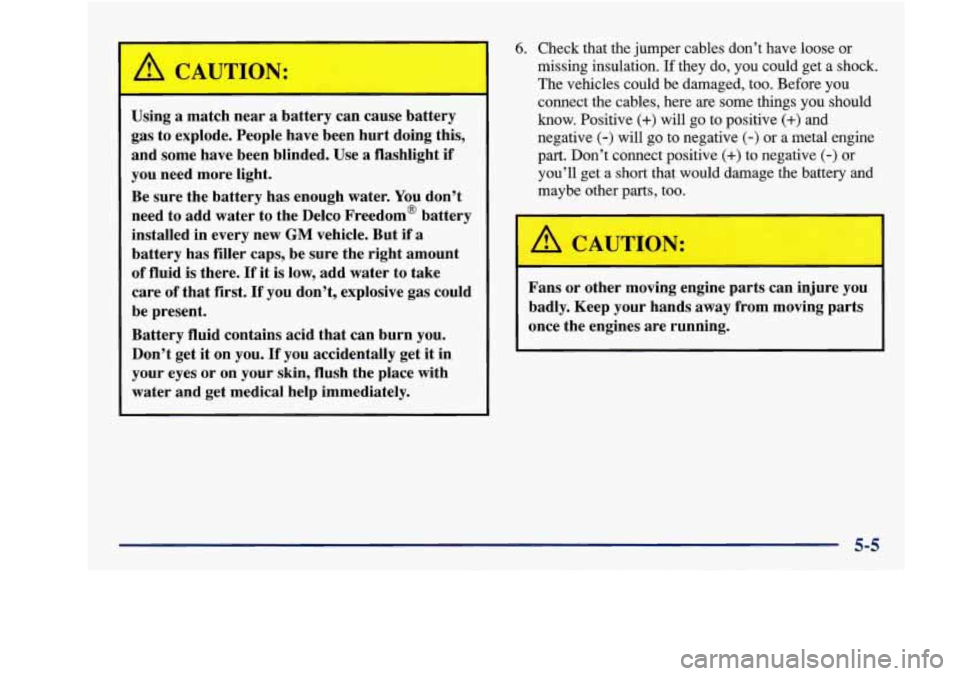
A CAUTION:
Using a match near a battery can cause battery
gas to explode. People have been hurt doing this, and some have been blinded. Use
a flashlight if
you need more light.
Be sure the battery
has enough water. You don’t
need to add water to the Delco Freedom@ battery
installed in every new
GM vehicle. But if a
battery has filler caps, be sure the right amount
of fluid is there.
If it is low, add water to take
care of that first. If you don’t, explosive gas could
be present.
Battery fluid contains acid that can burn you.
Don’t get it on you. If you accidentally get it in
your eyes or on your skin, flush the place with
water and get medical help immediately.
6. Check that the jumper cables don’t have loose or
missing insulation.
If they do, you could get a shock.
The vehicles could be damaged, too. Before you
connect the cables, here are some things
you should
know. Positive (+) will go to positive (+) and
negative
(-) will go to negative (-) or a metal engine
part. Don’t connect positive
(+) to negative (-) or
you’ll get a short that would damage the battery and
maybe other
parts, too.
Fans or other moving engine parts can injure you
badly. Keep your hands away from moving parts
once the engines are running.
5-5
Page 212 of 372
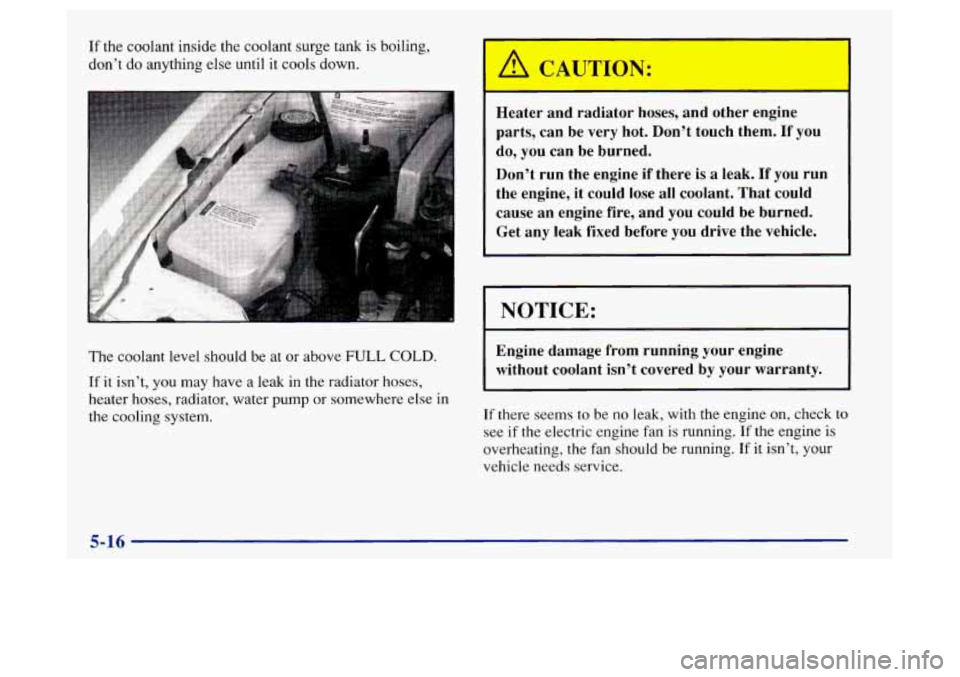
If the coolant inside the coolant surge tank is boiling,
don’t do anything else until
it cools down.
Lne coolant level should be at or above
FULL COLD.
If it isn’t, you may have a leak in the radiator hoses,
heater hoses, radiator, water pump
or somewhere else in
the cooling system.
J AUTION:
Heater and radiator hoses, and other engine
parts, can be
very hot. Don’t touch them. If you
do, you can be burned.
Don’t run the engine if there is
a leak. If you run
the engine, it could lose all coolant. That could
cause an engine fire, and you could be burned.
Get any leak fixed before you drive the vehicle.
I NOTICE:
Engine damage from running your engine
without coolant isn’t covered by your warranty.
If there seems to be no leak, with the engine on, check to
see
if the electric engine fan is running. If the engine is
overheating, the
fan should be running. If it isn’t, your
vehicle needs service.
5-16
Page 231 of 372
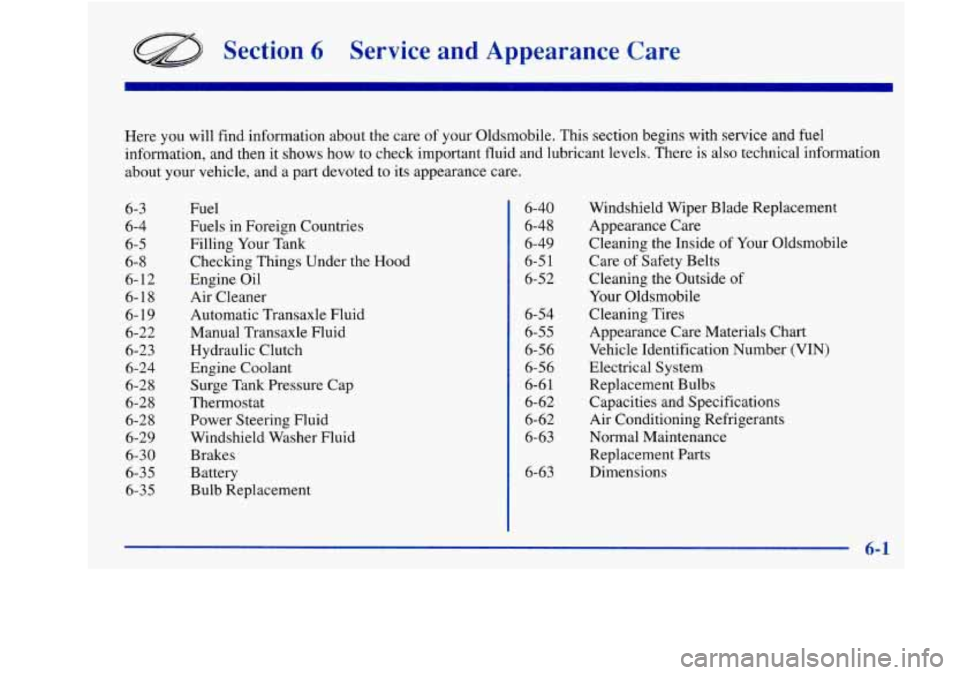
Section 6 Service and Appearance Care
Here you will find information about the care of your Oldsmobile. This section begins with service and fuel
information, and then it shows how to check important fluid and lubricant levels. There is also technical information
about your vehicle, and a part devoted
to its appearance care.
6-3
6-4
6-5
6-8
6- 12
6-18 6-
19
6-22
6-23
6-24
6-28
6-28
6-28 6-29
6-30
6-35
6-35 Fuel
Fuels
in Foreign Countries
Filling Your Tank
Checking Things Under the
Hood
Engine Oil
Air Cleaner
Automatic Transaxle Fluid
Manual Transaxle Fluid
Hydraulic Clutch
Engine Coolant Surge Tank Pressure Cap
Thermostat
Power Steering Fluid
Windshield Washer Fluid
Brakes
Battery Bulb Replacement 6-40
6-48
6-49
6-5
1
6-52
6-54
6-55
6-56
6-56
6-6 1
6-62 6-62
6-63
6-63
6-1
Windshield Wiper Blade Replacement
Appearance Care
Cleaning the Inside of Your Oldsmobile
Care of Safety Belts
Cleaning the Outside
of
Your Oldsmobile
Cleaning Tires
Appearance Care Materials Chart
Vehicle Identification Number (VIN)
Electrical System
Replacement Bulbs
Capacities and Specifications
Air Conditioning Refrigerants
Normal Maintenance
Replacement Parts
Dimensions
Page 233 of 372
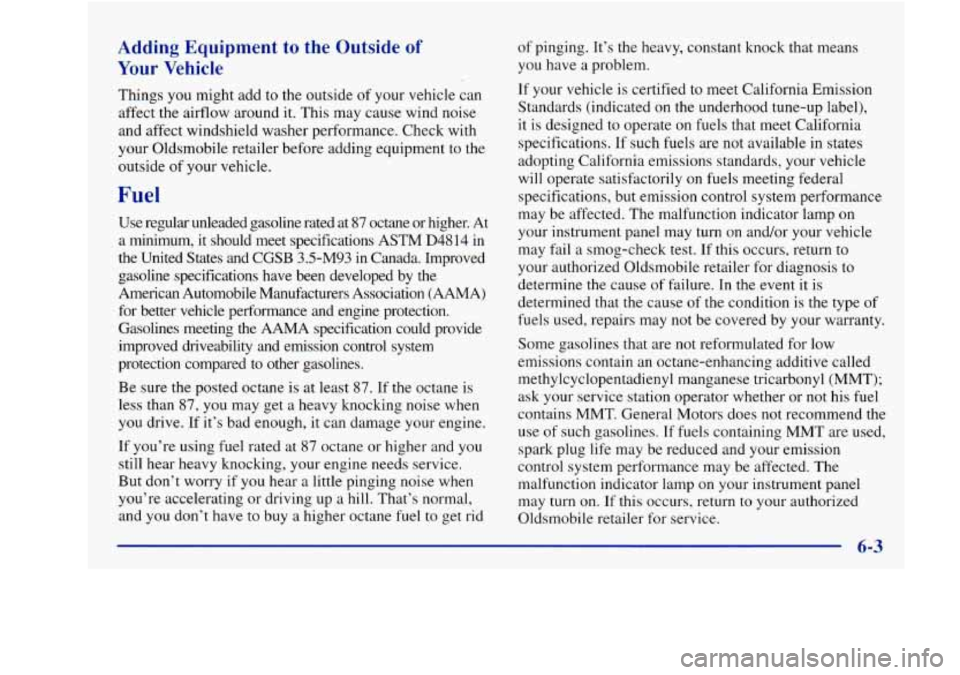
Adding Equipment to the Outside of
Your Vehicle
Things you might add to the outside of your vehicle can
affect the airflow around
it. This may cause wind noise
and affect windshield washer performance. Check with
your Oldsmobile retailer before adding equipment to the
outside of your vehicle.
Fuel
Use regular unleaded gasoline rated at 87 octane or higher. At
a minimum, it should meet specifications ASTM
D4814 in
the United States and CGSB 3.5-M93 in Canada. Improved
gasoline specifications have been developed by the
American Automobile Manufacturers Association (AAMA)
for better vehicle performance and engine protection.
Gasolines meeting the
AAMA specification could provide
improved driveability and emission control system
protection compared to other gasolines.
Be sure the posted octane is at least
87. If the octane is
less than
87, you may get a heavy knocking noise when
you drive. If it’s bad enough, it can damage your engine.
If you’re using fuel rated at
87 octane or higher and you
still hear heavy knocking, your engine needs service.
But don’t worry if you hear a little pinging noise when
you’re accelerating or driving up a hill. That’s normal,
and you don’t have to buy a higher octane fuel to get rid of
pinging. It’s the heavy, constant knock that means
you have a problem.
If your vehicle is certified to meet California Emission
Standards (indicated on the underhood tune-up label),
it is designed to operate on fuels that meet California
specifications. If such fuels are not available in states
adopting California emissions standards, your vehicle
will operate satisfactorily
on fuels meeting federal
specifications, but emission control system performance
may be affected. The malfunction indicator lamp on
your instrument panel may turn on and/or your vehicle
may fail a smog-check test. If this occurs, return to
your authorized Oldsmobile retailer for diagnosis to
determine the cause
of failure. In the event it is
determined that the cause of the condition is the type of
fuels used, repairs may not be covered by your warranty.
Some gasolines that are not reformulated for low
emissions contain an octane-enhancing additive called
methylcyclopentadienyl manganese tricarbonyl (MMT);
ask your service station operator whether or not his fuel
contains MMT. General Motors does not recommend the
use of such gasolines. If fuels containing MMT are used,
spark plug life may be reduced and your emission
control system performance may be affected. The
malfunction indicator lamp on your instrument panel
may turn on. If this occurs, return to your authorized
Oldsmobile retailer for service.
/A
Page 234 of 372
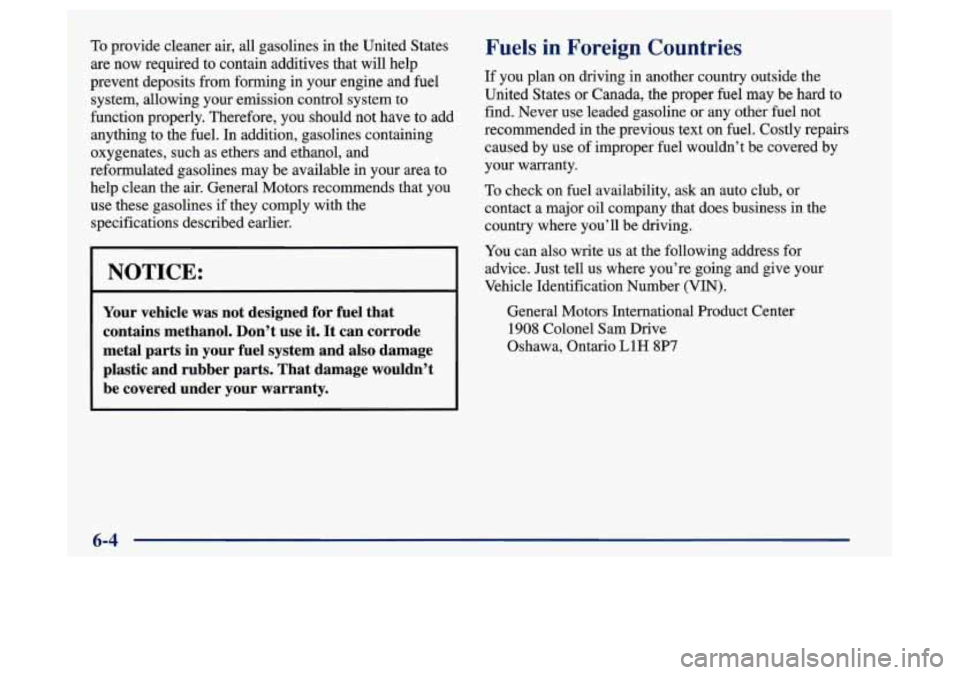
To provide cleaner air, all gasolines in the United States
are now required to contain additives that
will help
prevent deposits from forming in your engine and fuel
system, allowing your emission control system to
function properly. Therefore, you should not have to add
anything to the fuel. In addition, gasolines containing
oxygenates, such as ethers and ethanol, and
reformulated gasolines may be available in your area to
help clean the air. General Motors recommends that you
use these gasolines
if they comply with the
specifications described earlier.
NOTICE:
Your vehicle was not designed for fuel that
contains methanol. Don’t use it. It can corrode
metal parts in your fuel system and also damage
plastic and rubber parts. That damage wouldn’t
be covered under your warranty.
Fuels in Foreign Countries
If you plan on driving in another country outside the
United States or Canada, the proper
fuel may be hard to
find. Never use leaded gasoline or any other fuel not
recommended in the previous text on fuel. Costly repairs
caused by use of improper fuel wouldn’t be covered by
your warranty.
To check on fuel availability, ask an auto club, or
contact a major oil company that does business in the
country where you’ll be driving.
You can
also write us at the following address for
advice. Just tell us where you’re going and give your
Vehicle Identification Number (VIN).
General Motors International Product Center
1908 Colonel Sam Drive
Oshawa, Ontario
L1H 8P7
6-4
Page 238 of 372
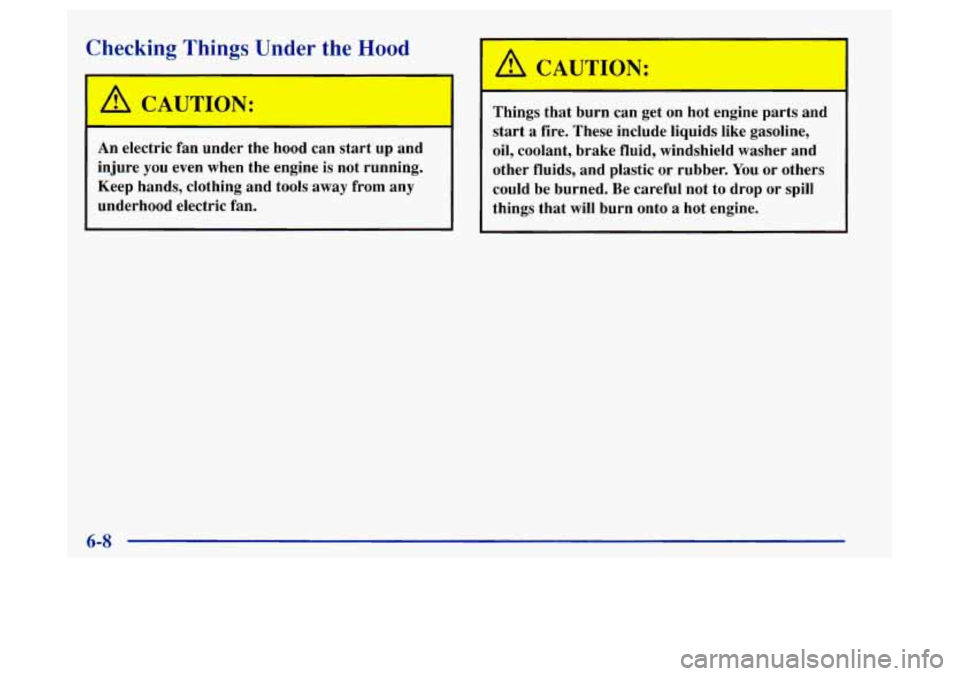
Checking Things Under the Hood
I A CAU'I :
An electric fan under the hood can start up and
injure you even when the engine is not running.
Keep hands, clothing and tools away from any
underhood electric fan.
A CAU JON:
Things that burn can get on hot engine parts and
start a fire. These include liquids like gasoline,
oil, coolant, brake fluid, windshield washer and
other fluids, and plastic or rubber. You or others
could be burned. Be careful not to drop or spill
things that will burn onto
a hot engine.
6-8
Page 242 of 372

Engine Oil
CHECK
OIL
If your vehicle is equipped
with the
3100 engine, you
have a
CHECK OIL light
on the instrument panel.
If the
CHECK OIL light on the instrument panel comes
on,
it means you need to check your engine oil level
right away. For more information, see “Check Oil
Light” in the Index. You should check your engine oil
level regularly; this is an added reminder. 2.4L Engine
It’s a good idea to check your engine oil every time you
get fuel. In order
to get an accurate reading, the oil must
be
warm and the vehicle must be on level ground.
6-12
Page 243 of 372

Checking Engine Oil
Pull out the dipstick and clean it with a paper towel or
cloth, then push it back in all the way. Remove
it again,
keeping the tip down, and check the level.
I
3100 Engine
The engine oil dipstick handle is yellow. The dipstick
handle for the
2.4L engine is located behind the engine.
The dipstick for the
3100 engine is located in front of
the engine, behind the fan.
Turn
off the engine and give the oil a few minutes to
drain back into the oil pan.
If you don’t, the oil dipstick
might not show the actual level.
6-13
Page 248 of 372
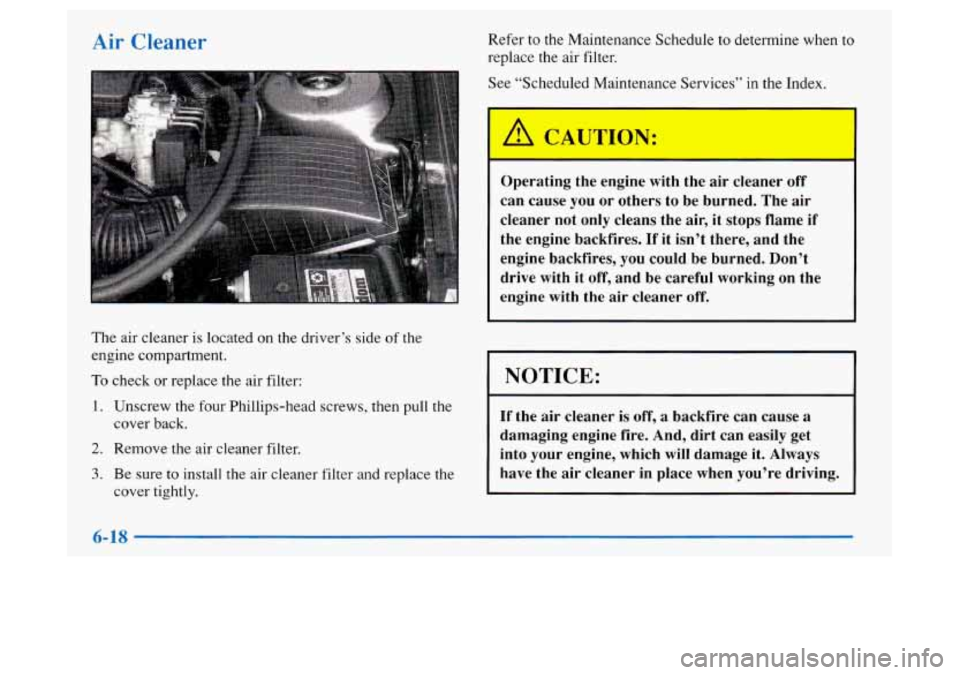
Air C- :aner
The air cleaner is located on the driver’s side of the
engine compartment.
To check or replace the air filter:
1. Unscrew the four Phillips-head screws, then pull the
cover back.
2. Remove the air cleaner filter.
3. Be sure to install the air cleaner filter and replace the
cover tightly. Refer
to the Maintenance Schedule to determine when to
replace the air filter.
See “Scheduled Maintenance Services” in the Index.
Operating the engine with the air cleaner off
can cause you or others to be burned. The
air
cleaner not only cleans the air, it stops flame if
the engine backfires. If it isn’t there, and the
engine backfires, you could be burned. Don’t
drive with it off, and be careful working
on the
engine with the air cleaner off.
NOTICE:
If the air cleaner is off, a backfire can cause a
damaging engine fire. And, dirt can easily get
into your engine, which will damage
it. Always
have the air cleaner in place when you’re driving.
Page 249 of 372
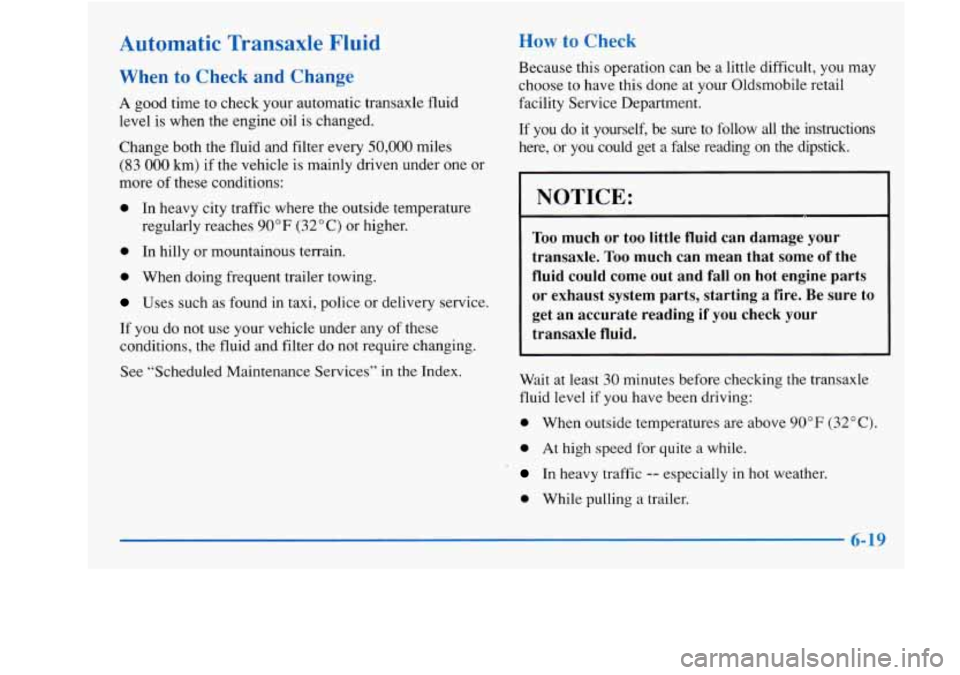
Automatic Transaxle Fluid
When to Check and Change
A good time to check your automatic transaxle fluid
level is when the engine oil is changed.
Change both the fluid and filter every
50,000 miles
(83 000 km) if the vehicle is mainly driven under one or
more
of these conditions:
0 In heavy city traffic where the outside temperature
regularly reaches
90°F (32°C) or higher.
0 In hilly or mountainous terrain.
0 When doing frequent trailer towing.
Uses such as found in taxi, police or delivery service.
If you do not use your vehicle under any of these
conditions, the fluid and filter do not require changing.
See “Scheduled Maintenance Services”
in the Index.
How to Check
Because this operation can be a little difficult, you may
choose
to have this done at your Oldsmobile retail
facility Service Department.
If you do it yourself, be sure to follow all the instructions
here, or you could get a false reading
on the dipstick.
I NOTICE:
Too much or too little fluid can damage your
transaxle.
Too much can mean that some of the
fluid could come out and fall on hot engine parts
or exhaust system parts, starting a fire.
Be sure to
get an accurate reading if
you check your
transaxle fluid.
Wait at least 30 minutes before checking the transaxle
fluid level if you have been driving:
0 When outside temperatures are above 90°F (32°C).
0 At high speed for quite a while.
In heavy traffic -- especially in hot weather.
0 While pulling a trailer.
6-19